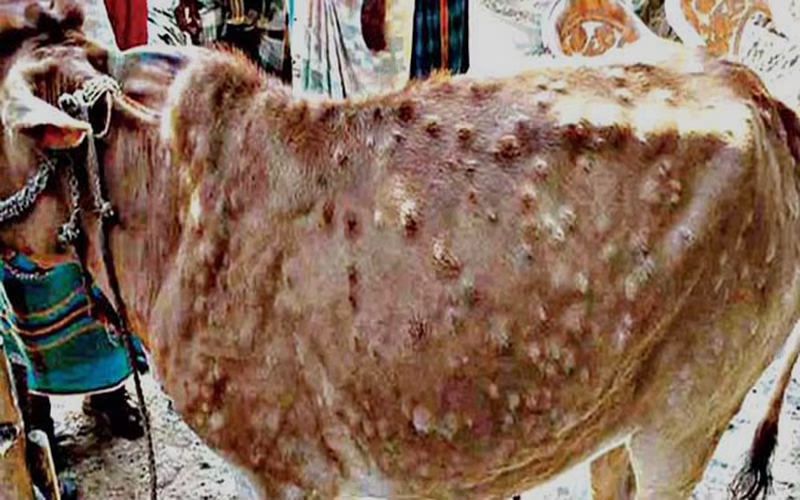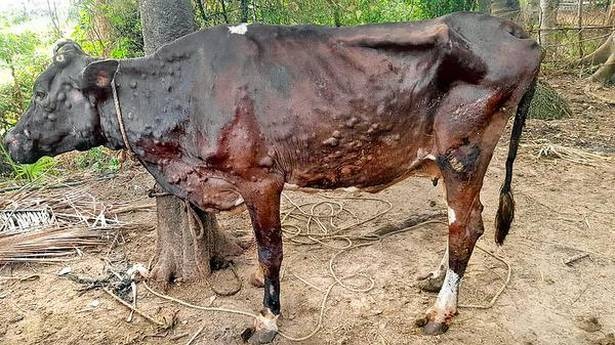ढेलेदार त्वचा रोग (एलएसडी): हजारों डेयरी किसानों के बीच प्रसंगिक परेशानी
The viral lumpy skin disease (LSD) has spread to cattle and buffalo in about a dozen big Indian states triggering concerns among thousands of dairy farmers. It was first reported from Mayurbhanj, Odisha in August 2019,” said Dilip Rath (Chairman, NDDB) but now already been reported in many states of our country such as Karnataka, West Bengal, Chhattisgarh, Jharkhand, Assam, Maharashtra, Madhya Pradesh, Kerala, Tamil Nadu, Telangana and Andhra Pradesh.
It is still not clear how many animals have been infected so far in the country. After the arrival of monsoon in India, the level of humidity become very high during moist weather leading to sever fly menace. These flies bite the livestock which causes hypersensitivity of the skin lesions but some time also spread diseases like cow pox better to say lumpy skin disease among the animals.

Lumpy skin disease (LSD) is a pox viral disease which is a non-zoonotic, vector borne and transboundary disease with limited host range and currently restricted to ruminants viz. cattle and water buffaloes. The disease is characterized by fever, multiple firms, circumscribed skin nodules, and necrotic plaques in the mucous membranes (chiefly of the upper respiratory tract and oral cavity) and swelling of the peripheral lymph nodes.
The arthropod vectors responsible for the disease spread include biting flies, mosquitoes and ticks. The disease is mainly attributing circumscribed nodules on skin causing severe emaciation, reduction in milk production, infertility.
Economic impact of lumpy-skin disease
LSD is associated with high morbidity but low mortality. Up to 45% of your herd can get infected and the mortality (death) rate may reach 10%. The disease causes emaciation (loss of body condition because of unwillingness to eat); temporary or permanent loss of milk production, lowered or complete loss of fertility in bulls and cows, abortion as wells permanent damage to hides (skin).
Major economic importance due to loss of production are severe emaciation, Lowered milk production, Abortion, Secondary mastitis, Loss of fertility and Extensive damage to hides. Overall, it mainly affects the economic value of animal as it will affect national and international livestock and its product trade.
Transmission LSD
Biting flies play the most important role in spreading the virus. The bitting flies (Stomoxy calictrans and Biomyia fasciata) and mosquitoes (e.g. Culex mirificens and Aedes natrionus), are also involved in mechanical transmission of disease.

Infections increase during the wet summer and autumn months when there are more flies. Virus is secreted in milk, nasal secretions, saliva, blood and lachrymal secretions forming indirect source of infection for animals sharing feeding and watering troughs.
Calves can be infected by drinking milk from a cow which has the disease. The disease can also spread through the saliva of infected animals when they use the same drinking trough. The virus also persists in the semen for up to 42 days post infection. The virus is not transmissible to humans.
Pathogenesis of LSD
Subcutaneous or intradermal inoculation of cattle with LSD virus results in the development of a localized swelling at the site of inoculation after 4 to 7 days and enlargement of the regional lymph nodes while generalized eruption of skin nodules usually occurs 7 to 19 days after inoculation.
Viral replication in pericytes, endothelial cells and probably other cells in blood vessel and lymph vessel walls causes vasculitis and lymphangitis in some vessels in affected areas. In severe cases infarction may result. In experimentally infected cattle LSD virus was demonstrated in saliva at least for 11 days after the development of fever, in semen for 42 days and in skin nodules for 39 days.
Viremia occurred after the initial febrile reaction and persisted for two weeks. Immunity after recovery from natural infection is life-long in most cattle; calves of immune cows acquire maternal antibody and are resistant to clinical disease for about six months.
Clinical signs
- Sudden onset of high fever that may exceed 41°C.
- Marked decrease in milk yield in lactating cattle.
- Depression, anorexia and emaciation also noticed.
- Discharges from the nose and eyes, and salivation.
- Enlarged superficial lymph nodes. Cutaneous nodules of 2–5 cm in diameter develop, particularly on the head, neck, limbs, udder, genitalia and perineum within 48 hours of onset of the febrile reaction. These nodules are circumscribed, firm, round and raised, and involve the skin, subcutaneous tissue and sometimes even the underlying muscles.
- Large nodules may become necrotic and eventually fibrotic and persist for several months (“sitfasts”); the scars may remain indefinitely. Small nodules may resolve spontaneously without consequences.
- Myiasis of the nodules may occur.
- Vesicles, erosions and ulcers may develop in the mucous membranes of the mouth and alimentary tract and in the trachea and lungs.
- Limbs and other ventral parts of the body, such as the dewlap, brisket, scrotum and vulva, may be oedematous, causing the animal to be reluctant to move.
- Bulls may become permanently or temporarily infertile.
- Pregnant cows may abort and be in anoestrus for several months.
Treatment
Unfortunately, there are no specific antiviral drugs available for the treatment of lumpy skin disease. The only treatment available is supportive care of cattle. This can include treatment of skin lesions using wound care sprays and the use of antibiotics to prevent secondary skin infections and pneumonia.
Anti-inflammatory painkillers can be used to keep up the appetite of affected animals. Intravenous fluid administration may be of benefit; however, this may not be practical in the field. The lack of treatment options for lumpy skin disease virus emphasizes the need of using effective vaccination for preventing disease.
Prevention and control
- Restrict vector movements: Vectors movement due to prevailing winds may cause disease transmission. Vector control methods like use of vector traps, use of insecticides can also be used for preventing the disease.
- Restrict movement: Movement of infected animals with LSD should be strictly prohibited to prevent the spread of transboundary disease. Within countries, if animal with such lesions are observed, they should be quarantined for inspection to prevent the rapid spread of disease.
- Vaccination: A live attenuated vaccine is available for LSD. Based on different strains of LSD virus, companies prepared vaccines.
In endemic areas systematic vaccination programs have provided the most effective control over the disease. In an outbreak situation diseased sheep or goats should be destroyed and their carcases burnt or buried.
This could be supplemented by vaccination of in-contact animals, and movement controls for both animals and vehicle should be applied. Cell-cultured attenuated and inactivated vaccines have been used to prevent disease. Inactivated vaccines provide about five months protection but there is no ready commercial source. The live attenuated vaccines give good immunity and are considered suitable in an emergency situation.
General measures to reduce the risk of LSD:
- Disinfectant footbath at the entrance of the stable.
- Disposable boot covers and suit for the visitors.
- Disinfection and disinfestation of vehicles prior to and after movements.
Avoid:
- Contacts between animals of different herds (e.g. on pasture).
- Grazing areas where nuisance flies are very abundant.
- Sharing animals, tools, vehicles, personnel with other farms.
Cattle and buffaloes are important livestock contributing substantially to the world economy. Lumpy skin disease is a serious disease of cattle and buffalo. As this disease in economically important, spread of this disease to larger geographical regions of Indian subcontinent will surely hamper the rural economy in particular. LSD can also lead to reduction in export of livestock and livestock products.
The reasons behind the entry of LSD in India need to be investigated along with epidemiological random screening in different regions to access the actual disease prevalence. Besides, effective quarantine methods, vector control methods, vaccination is the only method to prevent the disease.
Authors:
Dr. Anjali1, Dr. Gururaj VK1, Dr. Madhuri Patel2, Dr. Vandita Mishra3
1 Division of Physiology and Climatology, 2Division of Pharmacology, 3Division of Livestock Product Technology
ICAR-Indian Veterinary Research Institute, Izzatnagar-243122, India
Email:
